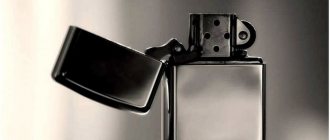The first lighters: be careful, hydrogen and weapons
The second prototype of the accessory, as we are used to seeing it, was the invention of the German scientist Johann Wolfgang Döbereiner, which was published in 1823. The gas device ran on hydrogen and sulfuric acid and was explosive but practical. The scientist's attempt to tame fire became the first full-fledged lighter, which was produced until 1880 and was a great success.
In 1867, Cartier, using the mechanisms of weapon flintlocks as a basis, created and patented a lighter. But the dimensions of the product were still far from the current ones due to the bulkiness of the flint based on the mineral flint and iron.
Lighter.
A lighter is a small device designed to produce fire repeatedly by producing a spark.
Depending on the fuel used, lighters can be gasoline or gas.
In lighters, various types of ignition can be used to produce a spark - flint, piezoelectric, etc.
History of the lighter.
The first similarity of a lighter in the form of a complete mechanism was developed by Leonardo da Vinci (1452-1519).
Leonardo da Vinci's device for producing fire consisted of many springs and wheels connected by chains to a flint. However, this machine was very cumbersome and had a terrifying appearance, so this invention of Leonardo was not widespread.
Dobereiner lighter.
The next step in the invention of lighters was made by the German chemist Johann Wolfgang Döbereiner (1780-1849).
At the beginning of 1823, Johann Wolfgang Dobereiner managed to invent the first tabletop lighter powered by hydrogen.
In the Dobereiner lighter (Dobereiner flint), instead of flint and steel, tiny particles of platinum were used, which, under the influence of oxygen, quickly heated up, igniting flammable hydrogen.
Dobereiner's flint soon began to be sold throughout Germany. Practical and relatively safe, Döbereiner's flint was a success, with production reaching 20,000 copies by 1829. It was produced until 1880.
The photo shows a Dobereiner flint.
At the same time, Dobereiner's flint lighter had an increased explosion hazard. Only half a century later did safer ignition mechanisms appear. They used a wick soaked in fuel, which was ignited by sparks created by striking metal wheels on flint.
History of the lighter and smoking habit.
At the turn of the 19th and 20th centuries, smoking became firmly in fashion, so the appearance of portable lighters made a huge impression in society both as a demonstration of the achievements of technical thought, and, of course, as a newfangled unique thing.
The Cartier company was the first to patent a new device for lighting a fire in 1867, and began producing these products in gold and silver.
In 1903, the Austrian chemist Karl Auer von Welsbach experimentally determined the optimal composition of the alloy from which flints for lighters are still made: iron with cerium. It was after this improvement that lighters decreased in size, became much safer and acquired an almost modern appearance.
There is also a legend about how the lighter was adapted to be lit with one movement of the hand.
Two English engineers, Frederick Charles Wise and Willie Greenwood, worked on improving the design of lighters at the beginning of the 20th century. One of the ideas led to the creation of a new type of gasoline lighter, in which the axis of the wheel for cutting out the flame is located horizontally, and not vertically, as before. This subtlety in the device made it possible to light a cigarette with one hand.
According to legend, one of the inventors (history is silent about which of these two) dreamed of lighting a cigarette with one hand, since he lost the other during the First World War. Apparently, the inability to light a cigarette on his own was one of the reasons that helped the engineer’s inventive talent emerge.
It is unknown whether the legend is true. However, after patenting their invention, Wise and Greenwood offered their own lighters.
Chief Alfred Dunhill believed that “even small ideas can make a fortune.” He reacted very favorably to the proposal.
To this day, since 1926, Dunhill lighters have been going on sale, which are works of design and talent. Many of them have become the world's best examples.
In 1932, American entrepreneur George Blaisdell developed the Zippo gasoline lighter, which was small in size, easy to use, reliable, and well designed.
In 1947, the first gas lighter appeared in Paris, where a special valve replaced the traditional wick.
In the 1970s, lighters appeared with an ignition system - from an electronic piezo.
The operation of the “electronic piezo” system uses the effect of the appearance of an electrical potential difference at the ends of a piezocrystal during its mechanical compression. The current is directed to two electrodes, between which a spark jumps.
The ignition system of lighters on an electronic battery is almost similar - a spark jumps when an electrical contact is created by pressing a button.
In 1986, Saroma began producing turbo lighters, famous for the fact that they do not go out even in the strongest winds.
A little later, Japanese specialists shocked the world with a lighter with a double flame: turbo and regular. Moreover, the smart mechanism itself decides which flame to light at the moment.
It seems that the progress of the evolution of lighters will not stand still. As long as there is at least one smoker left on the planet, he will be offered more and more sophisticated ways to light a cigarette.
A lighter is a device for producing fire. History of the lighter.
Women's site: I-the-most-beautiful.rf (www.i-kiss.ru)
Modern model
In 1903, a scientist from Austria, Karl Auer von Welsbach, succeeded in reducing the size and increasing the practicality of devices for making fire. He discovered the ferrocerium alloy and proposed making cutting stones for lighters from ordinary steel. This technology is used to this day: a jagged steel wheel, when in contact with a chair made of the so-called “Auer metal,” gives a spark, and it already ignites a wick with gasoline or gas supplied from the valve.
Lighter ZIPPO REPLICA 1935
RUB 3,640
BUY
Lighter ZIPPO 200 HORSE HEAD
RUB 2,310
RUB 1,686 BUY
Lighter ZIPPO CLASSIC 218
RUB 2,220
BUY
History of the lighter
16:18, 10 February 2017
1088
When asked which came first - the egg or the chicken, wise men still argue. But in the debate about the primacy of lighters and matches, the point has been made a long time ago. Believe it or not, lighters were born before the familiar sulfur matches. Therefore, we will talk about them first.
So, the first lighter prototype was developed by Leonardo da Vinci. Its original design as a complete mechanism consisted of many intricate wheels and springs connected by chains to a flint. This entire device was designed to produce fire with one movement. It must be said that the prehistoric lighter worked, but had such a terrifying appearance that it did not gain popularity among Da Vinci’s contemporaries.
Perhaps the invention would have sunk into oblivion if it were not for the fashion for smoking tobacco that swept the world. It was then that people began to seriously think about automating the process of lighting cigars and cigarettes.
The German chemist Johann Wolfgang Dobereiner was especially puzzled by this issue. It was he who invented the first hydrogen-powered lighter at the beginning of the 19th century. Moreover, the new tabletop lighter used tiny particles of platinum (instead of flint and steel). It was they who set fire to flammable hydrogen, heating it up under the influence of oxygen. And everything would be fine: ease of use + even, strong flame, but if handled carelessly, the miracle invention exploded with wild force. Needless to say, there were few people willing to light a cigarette with such a lighter?
Evolution of the lighter
The lighter, as we are used to seeing it, was invented already in the last century. Previously, although there were attempts to create a universal cigarette lighter (remember Dobereiner), the technical progress of those years did not allow all the plans to be properly implemented to make the lighter not only functional, but also safe.
Initially, lighters were produced in the manner of matches, when a special steel wheel (chair) struck sparks from a silicon rod. And they, in turn, set fire to gasoline. That’s how people would light cigarettes if it weren’t for the famous Austrian physicist. It was Karl Auer von Welsbach in 1903 who brought the lighter closer to its modern form. He found the optimal alloy composition (iron with cerium) for making flints for lighters. Moreover, the invention was made through trial and error, without relying on any theory. However, this does not prevent us from using this composition to this day.
Although lighters used to be different: bulky and expensive. Having such a miracle of technology at home was considered chic, and the design of the lighters was much more luxurious, in contrast to the simple plastic case today. But time passed, and manufacturers simplified lighters as much as possible, making them smaller, lighter and cheaper. Over the course of 100 years, a healthy machine that sparked fire turned into a harmless pocket lighter that absolutely everyone could afford.
Lighter manufacturers
It’s impossible to talk about lighters without mentioning the most famous manufacturers of this accessory. First on our list is Bowers.
Bowers
Bowers Tool And Die Company was founded by Ernest Bowers back in 1928 in Kalamazoo, Michigan. Initially, its main activity was not related to the production of lighters, but to metal processing. Moreover, the company was quite successful in its field. And probably no one would have even thought of expanding the scope of their activities if it were not for the founder of the company. The fact is that Ernest was a heavy smoker, and therefore, soon, in addition to its main activities, the company began to produce lighters under the brand “Kalamazoo Slide Sleeve Lighter”. Stylish, comfortable accessories for smokers were a resounding success among buyers, so the production of lighters not only did not die out, but also expanded.
Further more. Fredrik, Ernest's son, took the production of lighters to a new level, and they began to be successfully sold throughout the country. Several new models appeared, among which the “Storm Master” model was especially popular. Moreover, the demand was so great that the company had to produce about 4,000 lighters per day.
Army-Navy
In the 1940s, Bowers released the Army-Navy military model, after which it supplied 55% of all government purchases of lighters to American soldiers at the front. Moreover, the company even overtook even Zippo in sales volumes at that time, although little is known about this fact. Military lighters were of excellent quality coupled with a rather modest design. Some well-preserved examples can still be found today on Ebay.
Zippo
When you say lighter, you mean Zippo. This company has so firmly won the hearts of smokers from all over the world that they definitely deserve to say “thank you” to its founder, George Blaisdell. The entrepreneur started his business by importing Austrian IMCO lighters to the USA. Moreover, he was not able to sell a single item from the first batch, but he realized that he needed to improve the lighters so that they were actively sold and in demand. As a result, he created his own model - the legendary “windproof” Zippo. Since then, the company's motto is that they provide a lifetime warranty on their products in all weather conditions. And it was the right decision. Zippo lighters were in such great demand that Philip Morris used one of them (along with cowboys and horses) in its famous advertising campaign for Marlboro cigarettes.
There are also complaints about such lighters: some aesthetes complain that the form of the accessory is too simple and in some places even crude, but this is exactly what Blaisdell himself wanted at the time. But Zippo lighters can be used to trace the entire history of America. Designers willingly displayed all the sports and scientific achievements of the United States on lighters. This is probably why (plus because of the affordable price) lighters from this company are so eagerly collected by true Zippo fans.
By the way, the company has two features - it makes only gasoline lighters and labels its products with incomprehensible numbers. They say that this letter designation on the bottom indicates the tone of the sound that the lighter cap makes when opened. And this seems to be true, since different models actually emit sounds of different heights when opening the lid (not counting models with linings on the body, which make a dull click).
Fans of Zippo have determined that a lighter with the stamp “a” produces the note “A” when opened, with the letter “b” the note “B flat” sounds, with the letter “c” the note “C”, with the letter “d” the lighter produces the note “re” and so on along the staff until “h” - “si”. This version is not confirmed by the zippo company itself, but eyewitnesses claim that the rule works for certain models of lighters.
By the way, all zippo lighters, without exception, are produced only at the factory in Bradford. The only exception was the company's subsidiary factory, unknown to a wide audience, located in Canada in the city of Niagara Falls. It produced lighters from 1949 to 2002 and marked them with the inscription “niagara falls, ontario” on the stamp. In 2002, the factory closed, but before that a limited batch of collectible silver-plated lighters (25,000 pieces) was produced.
Dunhil
The Dunhill name also plays an important role in the history of lighters. The first Alfred Dunhill lighter appeared in 1923. A little later it was given the name Unique. Initially, Unique models were very elegant - they were decorated with ostrich or crocodile skin and had a gilded or silver-plated case. When Wise and Greenwood proposed their invention to the company, the company at that time already had a fairly well-known name and subsequently secured its reputation as one of the most sophisticated lighters in design. Today the company also produces a lot of interesting things, but sometimes it allows itself simpler lighters.
Ronson
Ronson was founded by Louis Aronson in New York in 1886. Initially, she was engaged in the manufacture of metal figurines, table lamps and other decorative items and was called “The Art Metal Works”. It would have been so, but in 1913, Louis Aronson received his first patent for a lighter, and from that time on, the history of producing quite high-quality lighters under this brand began. There were also some records. The company released the world's first automatic lighter, the Ronson Banjo, in 1926, which was a revolutionary product at that time. You could now light a fire with the touch of one finger. Of course, in our time this fact can only bring a smile, since this is how we all light a cigarette. But at that time it was an innovation.
In fact, you can write endlessly about lighters. The purpose of this article was to draw the attention of readers to such a familiar accessory - when lighting a cigarette again, remember the creator of the lighter and mentally say “thank you” to him.
Source: facte.ru
Subscribe to our Telegram channel. Stay on top of all the action! We work for you!
For the curious
If you are wondering if there was anything in the history of lighters before Da Vinci’s “wheel lock” drawings, which remained drawings, yes, there was. The truly first chapter in the history of this accessory can be considered the classic flint, known to us from children's fairy tales. This prototype lighter is a kit that includes three components:
- a piece of silicon oxide;
- chair (a strip of metal with notches and notches for friction);
- tinder (dried leaves and mushrooms, herb fibers, moss).
The spark when carving ignited the improvised “wood” - a fire was obtained. As you can see, the principle of operation is very similar to some modern products that run on gas fuel.
LiveInternetLiveInternet
Inventor: Johann Wolfgang Dobereiner. Country: Germany. Time of invention: early 19th century.. The prototype of a modern lighter, without a doubt, can be considered a flint. Flint was carried at the belt in a leather bag along with flint and tinder. The belt served as a... Lighter (history of invention)
Inventor : Johann Wolfgang Dobereiner
Time of invention : early 19th century
The prototype of a modern lighter, without a doubt, can be considered a flint. Flint was carried at the belt in a leather bag along with flint and tinder. The belt served to strike a spark, and the tinder served to maintain the fire. Tinder was obtained from rags and the surface part (hymenophore) of the fruiting body of the tinder fungus (hence the name), which parasitizes some trees, in particular birches.
The hymenophore was separated from the rest of the fruiting body, soaked in saltpeter and dried. When it became necessary to light, for example, a fire, a piece was broken off from the tinder and a spark was struck in the immediate vicinity of it using a flint and flint, which ignited the dry tinder.
They say that Leonardo da Vinci himself had a hand in the invention of the lighter. His invention was not distinguished by its elegance and miniature size: judging by the surviving features
I guess it was quite an impressive unit, consisting of chains, springs and flint.
But the very existence of such a project in such distant times is already impressive. But the musket or flintlock gun, known to us, again from adventure and historical novels, with its device for igniting gunpowder, which appeared in Europe around 1515, actually served as the impetus for the creation of the classic lighter. In the musket, a spark occurred as a result of strong friction of a special wheel on flint.
The first real lighter appeared only at the beginning of the 19th century. It was invented by the German chemist Johann Wolfgang Dobereiner. But since he used hydrogen as fuel, his brainchild cannot be called safe.
Lighters that did not threaten serious injury to their users appeared about fifty years after the testing of the Dobereiner mechanism. They used a wick soaked in fuel, which was ignited by sparks created by striking metal wheels on flint. She was the first to rush to patent a new invention. The original case and limited edition made Cartier lighters unique in all respects, and the demand for them from the powerful, rich and famous of this world exceeded the supply.
In 1903, the Austrian chemist Karl Auer von Welsbach determined the optimal composition of the alloy from which lighter flints are still made: iron with cerium. After this improvement, lighters became smaller in size and much safer. By the way, for a long time, in order to make fire with a lighter, you had to use both hands, since the axis of the wheel for cutting the flame was located vertically in them.
There is also a legend about how the lighter was adapted to light a cigarette with one movement of the hand. Two English engineers, Frederick Charles Wise and
Willie Greenwood, were engaged in improving the design of lighters at the beginning of the twentieth century. One of the ideas led to the creation of a new type of gasoline lighter, in which the axis of the wheel for cutting out the flame is located horizontally, and not vertically, as before. This subtlety in the device made it possible to light a cigarette with one hand.
The legend of this innovation lies in the fact that one of the inventors (history has not preserved exact data about which of these two) dreamed of lighting a cigarette with one hand, since he lost the other during the First World War. Apparently, the inability to light a cigarette on his own was one of the reasons that helped the engineer’s inventive talent emerge. Whether this was actually the case is not known for sure.
However, having patented their invention, Wise and Greenwood offered to sell such lighters to Alfred Dunhill. Fortunately, her office was located across the street from the inventors’ workshop. Alfred Dunhill himself, being the head of the. He reacted very favorably to the proposal. To this day, since 1926, Dunhill lighters have been going on sale, which are works of design and talent. Many of them have become the world's best examples: a table lighter - a clock, an aquarium lighter, a lighter in the shape of a golf ball, etc.
Since the early 30s, the design of lighters continued to change, but not fundamentally. Instead of two wheels to create a steel flame
use one, and the ignition mechanism was completely closed with a lid, which in turn was connected to the fuel tank. Thus, pressing the valve lifts the lid above the wick and sets in motion a mechanism that strikes a spark from the stationary flint.
Later, in 1947, the first gas lighter appeared in Paris, where a special valve replaced the wick. If you look back, you will notice that changes in the design of the lighter follow the path of simplifying the ignition mechanism and using more modern materials and scientific achievements in production.
So in the 70s, lighters with an electronic piezo system appeared. The operation of this system uses the effect of the appearance of an electrical potential difference at the ends of a piezocrystal during its mechanical compression. The current is directed to two electrodes, between which a spark jumps. The ignition system of lighters on an electronic battery is almost similar - a spark jumps when an electrical contact is created by pressing a button.
Cheap disposable lighters began to be produced in 1973 by Marcel Bick. Bick, while studying the market for pens and lighters, found that these are the items that are lost most often. So he decided to produce lighters that he wouldn’t mind losing.
In 1986, Saroma created the world's first gas turbo lighter with an anti-wind flame protection system.
In conclusion, we will name the most famous manufacturing companies that have contributed the most
th significant contribution to the development of lighter technology or design.
Zippo was founded by George Blaisdell. He began by obtaining an exclusive license to import Austrian lighters into the United States. I couldn’t sell a single one from the first batch, but I realized what exactly needed to be improved in order for the lighters to be sold and in demand. As a result, he created his own model, the truly legendary “windproof” Zippo.
Since then, the company's motto has been a lifetime guarantee of quality in all weather conditions. By the way, it was the Zippo lighter, along with cowboys and horses, that Philip Morris used in its large-scale advertising campaign.
Marlboro cigarette company. Some aesthetes reproach the company for the invariability of its simple “rough” form, but, in fact, this is what Blaisdell himself wanted. Using Zippo lighters, like paintings in an art museum, you can trace the history of all of America - its military, sports and even scientific achievements.
The company's designers instantly responded to any events and reflected them in engravings, enamel paintings, and simply in inscriptions on the cases. Such variety and quite affordable prices (even for old samples) make it very attractive to collect lighters from this company, which is what true Zippo fans do with success. And one more thing: Zippo only makes gasoline lighters.
The already mentioned company Alfred Dunhill Itd. - the recognized “king” of exquisite accessories for tobacco lovers in the United Kingdom and throughout the world. In 1923, the first Alfred Dunhill lighter appeared, which was later given the name Unique. The first Unique models were indeed elegant - as a rule, they had a gold or silver plated case and were decorated with crocodile or ostrich skin. By the time Wise and Greenwood offered their invention to the company, the company already had a fairly well-known name and in the future
has cemented its reputation as one of the most sophisticated in the artistic and design of its lighters.
Saroma is a Japanese company that began operations in 1940, but began producing lighters 8 years later. Today it is a well-known brand and is sold in 73 countries around the world. The company firmly follows the principles of combining age-old traditions with the introduction of the latest technologies in the production of lighters. It’s no wonder that Saroma, with Japanese care and consistency, expanded its product range step by step. The company produces both gasoline and gas lighters, with silicon ignition systems, with piezo, and even lighters with an electronic battery.
Moreover, in 1986, Saroma was the first in the world to begin producing turbo lighters, the flames of which cannot be extinguished by any wind. This is not the end of the Japanese interest in using the latest technologies in the production of lighters. Latest achievement. One lighter nozzle can produce two types of flame: one that does not go out in the wind and a regular one. The most interesting thing is that the mechanism itself decides which flame should burn and under what conditions.
Diplomat is a Swiss company founded in 1956. This company is distinguished by high quality and impeccable operation of its mechanisms (just like Swiss watches). At the same time, the design of the lighters is also impeccable and distinguished by sophistication. The company produces very elegant gift sets, for example, a lighter and a pen, as well as other accessories necessary for every man who cares about his image.
Dupont is a famous French company that produces not only lighters, but also a complete accessory set for a business person. The lighters are elegant, high quality and amazing in design. As a rule, they have a gold or silver plated case, decorated with leather or engraving.
Another Japanese manufacturer of lighters, Amatti, began its activities in 1972 and currently occupies a prominent place in almost all price segments. By the way, this company is so far the only one that has offered a special brand of its products for the Russian market - Angara lighters.
Swedish Match, which has been producing matches since 1917 and reached a quarter of the world market share by the end of the 80s, entered the competition in the lighter market in the second half of the 80s after acquiring the English company Wilkinson Sword. Their Cricket brand very quickly gained popularity in the segment of inexpensive lighters.
Companies such as Colibri, Saffo, Ronson, Thorens and La Nationale are quite widely known throughout the world. We should also pay tribute to companies operating in a more affordable price range that produce disposable gas lighters: Swedish Match (Cricket brand), BIC, Amatti. The products of these companies are aimed at the mass consumer, are known in many countries and are extremely popular.
Lighters
What came first: an egg or a chicken, matches or a lighter?
Did you know that safe matches appeared later than safe lighters?
The first attempts to create them were made since the times of Ancient China, yes. But modern matches were created only in 1855 by a chemist from Sweden, Johan Lundström. Other scientists' previous prototypes were chemically unsafe, spontaneously combusted during storage, and burned the face and hands during use. Lundstrem's invention has come down to us, having undergone almost no modifications.
LOL54.RU
According to a dry encyclopedic definition, a lighter is a small device designed to repeatedly produce fire by creating a spark generated by the impact of a flint on a flint. So stingy and dispassionate. Meanwhile, modern lighters are much more than just “devices for producing fire.” These days, lighters are collectibles, important fashion accessories, and great corporate gifts on February 23rd. Leonardo da Vinci was the first to think about the invention of a lighter. His original device for producing fire simply consisted of many springs and wheels connected by chains to a flint. There were also people like the crazy German chemist Dobereiner. In the 19th century, he came up with a tabletop lighter that ran on hydrogen. History is silent about the victims and destruction of this infernal machine.
Only half a century later did safer ignition mechanisms appear. They used a wick soaked in fuel, which was ignited by sparks created by striking metal wheels on flint. By this time, smoking had become firmly established in fashion, so lighters made a huge impression on the wealthy sections of society both as an achievement of technical thought and, of course, as a newfangled expensive thing. The Cartier company was the first to patent a new invention in 1867 and began producing these products in gold and silver. In 1903, the Austrian chemist Karl Auer von Welsbach experimentally determined the optimal composition of the alloy from which flints for lighters are still made: iron with cerium. It was after this improvement that lighters decreased in size, became much safer and acquired an almost modern appearance.
There is also a legend about how the lighter was adapted to light a cigarette with one movement of the hand. Two English engineers, Frederick Charles Wise and Willie Greenwood, were engaged in improving the design of lighters at the beginning of the twentieth century. One of the ideas led to the creation of a new type of gasoline lighter, in which the axis of the wheel for cutting out the flame is located horizontally, and not vertically, as before. This subtlety in the device made it possible to light a cigarette with one hand. The legend of this innovation lies in the fact that one of the inventors (history has not preserved exact data about which of these two) dreamed of lighting a cigarette with one hand, since he lost the other during the First World War. Apparently, the inability to light a cigarette on his own was one of the reasons that helped the engineer’s inventive talent emerge. Whether this was actually the case is not known for sure. However, having patented their invention, Wise and Greenwood offered to sell such lighters to Alfred Dunhill. Fortunately, her office was located across the street from the inventors’ workshop. Alfred Dunhill himself, being the head of the. He reacted very favorably to the proposal. To this day, since 1926, Dunhill lighters have been on sale, which are works of design thought and talent. Many of them have become the world's best examples: table lighter-clock, lighter-aquarium, lighter in the shape of a golf ball, etc.
Since the early 30s, the design of lighters continued to change, but not fundamentally. Instead of two wheels, they began to use one to create a flame, and the ignition mechanism was completely covered with a lid, which in turn was connected to the fuel tank. Thus, pressing the valve lifts the lid above the wick and sets in motion a mechanism that strikes a spark from the stationary flint. Later, in 1947, the first gas lighter appeared in Paris, where a special valve replaced the wick. If you look back, you will notice that changes in the design of the lighter follow the path of simplifying the ignition mechanism and using more modern materials and scientific achievements in production. So in the 70s, lighters with an electronic piezo system appeared. The operation of this system uses the effect of the appearance of an electrical potential difference at the ends of a piezocrystal during its mechanical compression. The current is directed to two electrodes, between which a spark jumps. The ignition system of lighters on an electronic battery is almost similar - a spark jumps when an electrical contact is created by pressing a button.
In 1986, Saroma began producing turbo lighters, famous for the fact that they do not go out even in the strongest winds. And recently, Japanese specialists shocked the world with a lighter with a double flame: turbo and regular. Moreover, the smart mechanism itself decides which flame to light at the moment. Progress will not stand still. As long as there is at least one smoker left on the planet, he will be offered more and more sophisticated ways to light a cigarette. Do you remember what a sensation a cheap electronic wristwatch made in Honkong with a built-in piezo lighter made on others? This was the last squeak! Since there are lighters-openers, lighters-pen, with built-in sets of nail files, compasses, flashlights, currency detectors and video cameras, then we can predict the next steps of enterprising manufacturers of this thing.
In conclusion, we will name the most famous manufacturing companies that have made the most significant contribution to the development of technology or design of lighters. Zippo was founded by George Blaisdell.
The prototype for Zippo was a windproof lighter made in Austria, which he saw in the hands of his companion at a party. The legend describes the history of the zippo lighter as follows:
In 1932, during the “Great Depression” in distant America, in the oil industry town of Bradford (Pennsylvania), a certain George Blaisdell came to dance at an ordinary village club. He was a co-owner of a company producing simple oil production equipment. From his youth he dealt with metal and had a considerable desire for invention.
George soon got tired of dancing and empty talk about politics, and he went out to smoke on the veranda of the club, where he found his friend Dick Dresser, puffing and trying to remove the cap from his old Austrian lighter. Dick was a fairly wealthy man, and George allowed himself the remark: “Why don’t you buy a more presentable lighter?” Dick finally pulled off the lid and clicked the wheel. Despite the rather strong wind, the lighter lit and Dick lit his cigarette. “Because this one works!” - Dick muttered in response to George's question. At that moment a thought struck George: “lighter! This is what a person constantly needs, regardless of his financial situation!” Since then, George's mind has been occupied with the idea of producing reliable lighters that are accessible to everyone.
At first, Blaisdell decided that he could sell Austrian lighters on the American market, and ordered a whole batch of such lighters. However, disappointment awaited him: he could not sell a single piece. Then George, with his usual ingenuity, slightly improved the design of the unnamed Austrian prototype, giving the body a rectangular shape and making the lid hinged so that the lighter could be operated with one hand, but otherwise it underwent virtually no changes, even the number of holes in the windproof walls remained the same. After this, Blaisdell opened a small factory producing his own lighters, initially employing only 6 people. At first he wanted to call his invention “zipper” simply because he liked the sound of the word, but this name turned out to be already patented, and he settled on “zippo”. The new lighter was liked by customers due to its simplicity and reliability of design and immediately gained success in the market, largely thanks to the successful advertising campaign of George Blaisdell. Production grew rapidly and on March 3, 1936, George was issued patent number 2032695 for the zippo lighter design. After the Second World War, the production and sale of zippo lighters increased sharply due to the release of a large number of new models and a very active advertising campaign in the press. Many lighters from the late 1940s and early 1950s are true masterpieces with hand-painted designs; in those same years, there began a boom in placing logos of various companies on lighters and using them as souvenir and image products. but all these years the design and construction of the lighter remained unchanged, as it has survived to this day.
One of the main advertising ploys that George came up with from the very first day of production of lighters was their lifetime warranty. this means that a lighter of any age and in any condition, if broken, is repaired by the company free of charge with the replacement of the necessary parts. This rule is still observed today: once authenticity is established, any lighter is subject to free repair, regardless of what happened to it. The only part of the lighter that is not covered by the warranty is the external finish and patterns on the body, which on many models can wear out and be erased over time, as well as inserts and emblems, but these can also be replaced free of charge if similar ones are available at the service center .
All zippo lighters from the very first day of release have a unique stamp on the bottom with the zippo logo; early models have a patent number on the stamp. Since 1957, a stamp was placed on the bottom of all zippo lighters indicating the year (later and month) of the lighter's release. Before 1966, the year of manufacture was indicated by a sequence of dots (.) to the left and right of the logo. From 1966 to 1973, the production year was indicated by a combination of vertical stripes (|), from 1974 to 1981 - forward slashes (/), from 1982 to June 1986 - backslashes (). Since July 1986, the stamp also carries information about the month the lighter was produced. To the left of the logo, letters from a to l indicate the month (a - January, b - February, etc.), to the right - the year. In 1986, the year designation began with the Roman numeral ii and ended in 2000 with xvi. Since 2001, the year designations have switched to Arabic numerals, 01 means 2001, etc. For example, a stamp with the designations e 04 indicates a lighter produced in May 2004. Since 1982, zippo began producing copies of models from the first years of production, first a copy of the 1932 model, later - models of 1937 and 1941. The stamps on the bottoms of such modern copies repeat the original stamp of lighters of those years with the patent number, but such a copy can be distinguished by the additional presence of a modern alphanumeric designation of the date of issue.
In addition to the date and logo, stamps on some models may contain additional information, such as the name of the material from which the lighter is made, or the decals of special limited editions of collectible lighters.
The stamp on the bottom of a zippo lighter is the most important sign of its authenticity for collectors; it determines both the year of manufacture and the authenticity of the lighter.
zippo and the Second World War During the Second World War, the zippo company completely switched to supplying lighters to the US armed forces, without selling a single copy on the civilian market. lighters of those years were made of steel and specially coated with black paint (black crackle) so that the enemy could not recognize the position of the soldiers by the reflection of the zippo case and, in addition, to protect the case from rust. The zippo lighter became a kind of talisman for American soldiers, greetings from a distant homeland. There are many legends about zippo lighters used during the war, but the most famous lighter of that time belonged to a soldier named Walter Nadler, who landed in Normandy on June 6, 1944. His name and the date of the landing are scratched on it. The lighter was found by a Zippo employee in the early 90s and is now on display at the company's museum in Bradford.
There is a legend that the letter designation on the bottom of modern lighter models indicates the tone of the sound made by the lid when opened. In fact, oddly enough, different models of lighters produce a different pitch of sound when opening the lid (with the exception of models with overlays on the body, which is why they produce a dull click rather than a ringing sound), and for some modern models this statement is true. For example, a lighter with a stamp when opened gives the note "A", with the letter B - the note "B flat", with the letter C - the note "C", with the letter D - the note "D" and so on until h - "B" . This version has not been confirmed in any way by the zippo company itself, but nevertheless, when checked, it turns out that the rule really works for certain models of lighters. The cost of collectible zippo lighters depends on many factors: metal, design, degree of rarity and preservation. The highest price paid by a collector for a lighter was $18,000. It was a perfectly preserved 1933 model purchased at a zippo collectors' meeting in Tokyo in 2001. a year later, the zippo company itself bought a similar lighter from the first years of production from another collector for its museum for $12,000.
The most expensive commercially produced zippo lighter is the one made from 18k gold, costing over $3,500.
All zippo lighters are made only in the Bradford factory and nowhere else. The only exception was the company's subsidiary factory in Niagara Falls, Canada, which produced lighters from 1949 to 2002. Lighters produced by this factory were marked with the inscription “niagara falls, ontario” on a stamp, and the production date code began to be printed on them only in 1987. When the factory closed in 2002, a limited (25,000 pieces) batch of collectible lighters with silver plating was produced; all lighters of this release were numbered.
The already mentioned company Alfred Dunhill Itd. - the recognized “king” of exquisite accessories for tobacco lovers in the United Kingdom and throughout the world. In 1923, the first Alfred Dunhill lighter appeared, which was later given the name Unique. The first Unique models were indeed elegant - as a rule, they had a gold or silver plated case and were decorated with crocodile or ostrich skin. By the time Wise and Greenwood proposed their invention to the company, the company already had a fairly well-known name and subsequently established a reputation for being one of the most sophisticated in the art and design of its lighters.
Diplomat is a Swiss company founded in 1956. This company is distinguished by high quality and impeccable operation of its mechanisms (just like Swiss watches). At the same time, the design of the lighters is also impeccable and distinguished by sophistication. The company produces very elegant gift sets, for example, a lighter and a pen, as well as other accessories necessary for every man who cares about his image.
Dupont is a famous French company that produces not only lighters, but also a complete accessory set for a business person. The lighters are elegant, high quality and amazing in design. As a rule, they have a gold or silver plated case, decorated with leather or engraving.
Another Japanese manufacturer of lighters, Amatti, began its activities in 1972 and currently occupies a prominent place in almost all price segments. By the way, this company is so far the only one that has offered a special brand of its products for the Russian market - Angara lighters. Swedish Match, which has been producing matches since 1917 and reached a quarter of the world market share by the end of the 80s, entered the competition in the lighter market in the second half of the 80s after acquiring the English company Wilkinson Sword. Their Cricket brand very quickly gained popularity in the segment of inexpensive lighters.
Companies such as Colibri, Saffo, Ronson, Thorens and La Nationale are quite widely known throughout the world. We should also pay tribute to companies operating in a more affordable price range that produce disposable gas lighters: Swedish Match (Cricket brand), BIC, Amatti. The products of these companies are aimed at the mass consumer, are known in many countries and are extremely popular.











